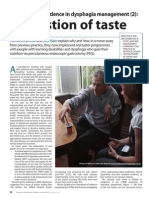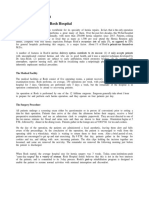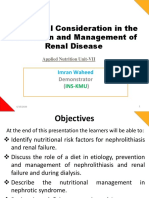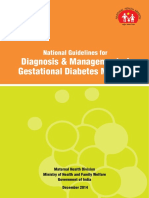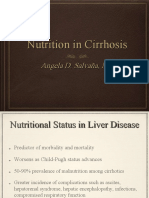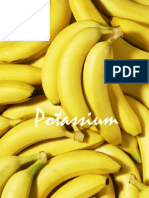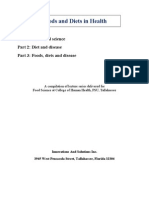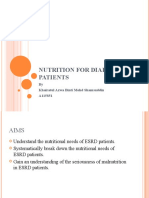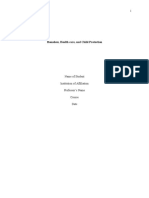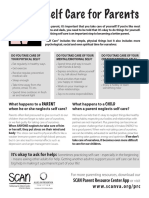Nutrition and Renal Disease
Nutrition and Renal Disease
Uploaded by
franzcatchieCopyright:
Available Formats
Nutrition and Renal Disease
Nutrition and Renal Disease
Uploaded by
franzcatchieOriginal Description:
Copyright
Available Formats
Share this document
Did you find this document useful?
Is this content inappropriate?
Copyright:
Available Formats
Nutrition and Renal Disease
Nutrition and Renal Disease
Uploaded by
franzcatchieCopyright:
Available Formats
NUTRITION AND RENAL DISEASE
Eat just enough protein. Excess intake of protein would lead to the accumulation of waste products like
urea, creatinine and uric acid in the blood. Consumption of white meat (chicken, fish and eggs) is better
than the intake of red meat (pork and beef). Avoid concentrated foods like organ meats, kare-kare,
laing and processed foods.
Phosphorus level in the blood increases as kidney function declines, therefore, it is important to avoid
foods high in this nutrient, such as:
o Excess intake of milk, cheese and other dairy products
o Legumes like beans and mongo beans
o Chocolate and cocoa
o Pinipig, peanuts and pili nuts
High levels of phosphorus causes skin itchiness and disturbances in the bone and calcium metabolism
in the body. Doctors prescribe phosphate binders to correct levels of phosphorus in the blood.
Avoid salty foods and condiments (bagoong, dried fish, salted egg, chips, soy sauce, fish sauce, vetsin,
broth cubes). Excess sodium in the diet could cause high blood pressure and edema.
Eat only the recommended amount of fruits and vegetables especially if you are on hemodialysis. High
levels of potassium in the blood causes irregular heartbeat, palpitation and worse could lead to cardiac
arrest.
Drink the right amount of water or follow what is prescribed by your doctor. Avoid excess intake of fluids
especially when there is edema or oliguria.
Eat enough carbohydrates and fats for daily energy source of the body. Fat can be eaten in allowed
amount, through frying and sauting of foods. To avoid increases in the blood cholesterol levels, buy
and use vegetable and plant oil sources.
Avoid eating of simple sugars and sweets (cakes, candies, chocolate bars) if you have diabetes. These
foods can increase your blood glucose level and may create another problem.
KIDNEY TRANSPLANT DIET
The diet for renal transplantation is to provide adequate calories and protein to counteract the catabolic effect
of surgery during the early post transplant period and to manage the nutritional side-effect of
immunosuppressive drugs.
Nutrition after kidney transplantation is given a well-balanced diet. This means that it contains foods
from all food groups-egg, meat, fish, chicken, milk, cheese, fruits, vegetables, cereals, sugars. Initially,
during the first month after transplantation, the patient is advised short-term dietary management. This
may expedite wound healing, muscle growth and development and prevent drug-induced diabetes
commonly observed after transplantation. However diet-related complication that may lead to organ
rejection. Therefore, the following nutritional guidelines are recommended.
Short-Term Management (During the first month after transplantation)
Adequate protein intake to replace further protein breakdown due to high doses of steroid. Good protein
food sources are meat, fish, poultry, egg, milk and milk products.
Eat small amount of simple sugars: honey, jams, jelly, candy, softdrinks, cakes and sweet desserts.
Limit intake of salt, seasonings and processed foods to prevent increase in blood pressure and fluid
retention.
Long Term Nutritional Management
Lower protein intake as steroid dosage is reduced.
Eat less fat and cholesterol to reduce the risk of developing heart disease and increase in body weight.
Continue limiting intake of simple sugars and salty condiments and high-sodium containing foods.
Mineral and vitamin supplements may be taken as allowed by the physician
Other renal diets commonly used in kidney disease management are:
Low Phosphorus
Foods rich in protein are also rich in phosphorus. Thus, restricting protein also restricts phosphorus in the
diet.
Foods to be avoided:
Cheese
Chocolate
Cocoa
Fish, dried
Legumes
o Chick peas
o Munggo
o Sitaw
o Kadyos
Corn
Milk
Oatmeal
Meats
o Bacon
o Beef
o Chicken
o Heart
o Kidney
Nuts-peanuts
Pinipig
Kalabasa
Misua
Low Calcium Diet
This diet is advised to patients with calcium oxalate renal stones. It is designed to minimize the
concentration of the components associated in the formation of renal stones.
Examples of foods high in calcium: green leafy vegetables like malunggay and saluyot, calcium-fortified
fruit juices and other beverages, too much intake of milk and dairy products, dried beans, sardines and
anchovies.
Low Oxalate Diet
An oxalate-restricted diet is indicated for individuals with calcium oxalate renal stones. The dietary
modification is designed to minimize its concentration in the urine associated with its formation. A regular or
general diet is provided with avoidance of foods known to be high in oxalate.
Examples of foods high in oxalate: Chocolate (beverages and drinks, candies and bars), soy beans and
products, strawberries, ripe tamarind, green leafy vegetables, celery, eggplant, wheat germ/bran, cassava,
sweet potato, white corn, all nuts and products, tea and draft beer.
Low Potassium Diet
Potassium is an essential mineral needed by the body for normal nerve transmission and muscle
contraction, including the normal beating of the heart.
A low potassium diet is prescribed for people with renal disease, hyperkalemia or Addisons disease in
which the potassium in the blood is high. Low level should be less than 2 grams per day since the usual intake
from foods is 2-6 grams per day.
Foods to be avoided are the following:
green leafy vegetables such as malunggay, spinach, talbos ng kamote and sili
fruits such as banana, orange, buco, siniguelas, lanzones, melon and dried fruits
wheat and wheat products such as oatmeal, misua and wheat bread
crabs
legumes and beans
coconut milk
chocolates (bars, candies, beverages)
molasses
cola drinks
Low Protein
This diet provides 30-40 grams protein per day only, 2/3 of the amount is derived from intake of meat, fish
and eggs (high biological value protein) and the remaining 1/3 coming from rice, sugar, fats and vegetables
(low biological value protein).
It aims to prevent or minimize muscle and tissue breakdown, hence sufficient calories are provided with
liberal use of carbohydrates and fats.
Too little protein, the person develops malnutrition. Too much protein, the blood urea rises. For people with
renal insufficiency, restricting protein may help protect the remaining nephrons.
The diet follows the regular menu selection except that intake of protein is limited. Foods restricted are
internal organs, dried fish, viands cooked with coconut milk, beans and legumes, high sodium containing
canned meats and milk in excess amount.
Low Purine
A low purine diet restricts the amount of purine to only 150 mg per day. The low purine diet diet is prescribed
as an adjunct to drug therapy for gout, arthritis and other disorders affecting purine metabolism. It is also
recommended for people with uric acid stone. Daily consumption of water should be increased since this helps
in eliminating uric acid. A high intake of carbohydrates also favors uric acid secretion while a high fat intake
favors its retention.
Food to be Avoided:
Internal organs (Pork, Chicken, Beef)
o Liver
o Lung
o Kidney
o Tongue
o Heart
o Small and large intestines
Fishes
o Tanigue
o Dilis (Anchovies)
o Alumahan
o Matang Baka
o Tamban
o Tunsoy
Shellfish
o Halaan
o Tahong
o Talaba
Legumes and dried beans
o Chick peas
o Lima beans
o Mungo beans
o Sitaw
o Garbanzos
DIABETIC DIET
The diet for a diabetic patient is designed to maintain near-normal blood glucose and lipid levels, to
provide adequate energy from foods, prevent/delay disease complications and promote good nutritional
well-being.
The diet of a diabetic person should be well balanced. Foods from the different food groups (meat,
poultry, milk and products, legumes, vegetables, fruits, rice and cereals) should be included in the diet.
The caloric amount of food and regular eating time is emphasized in the nutritional management of the
patient. The following guidelines are also recommended:
o Maintain the desirable body weight.
o Eat foods rich in fiber: rice, bread, root crops, fresh fruits and vegetables. Fiber in foods helps to
control blood sugar and cholesterol levels.
o Eat less fat to avoid/delay having cardiovascular diseases.
o Avoid simple sugars in the diet.
o Use less salt/seasoning and avoid eating too much processed and salty foods to help control
blood pressure.
o Refrain from drinking alcoholic beverages. If so desired, consult a dietitian on how to work it in
the meal
Follow a regular meal plan.
CARDIOVASCULAR DIET
Cardiovascular diseases remain one of the leading causes of mortality to almost all population. Efforts
to fight heart diseases have led to valuable health discoveries and public education awareness. The
following are recommendations for a healthy lifestyle and proper food and dietary habits:
o Follow a low fat and a low cholesterol diet.
o Eat more fruits, vegetables and rootcrops. Fiber present in these foods helps in lowering blood
cholesterol and lipid levels and promoting normal bowel movement.
o Avoid too much consumption of salty foods (bagoong, processed meats) for better control of
blood pressure and prevent edema.
o Exercise regularly for good muscle tone and body weight maintenance.
o Do not smoke.
o Avoid alcohol and other liquors, since they are high in fat and cholesterol. Avoid too much intake
of caffeine-containing foods that may cause heart irregularities.
o Eat a balanced meal. Stay away from too much restaurant foods that increase your sodium and
cholesterol intake.
o Learn to relax. Yoga, meditation and music help fight stress that weakens the immune system.
o Consult your doctor for a regular medical check-up.
Low Fat
A low fat diet is an allowance of food and drink with the total amount of fat limited to 15% of the total
calories. This diet is advised for weight reduction, heart disorder, gall bladder inflammation, portal
cirrhosis, hepatitis, pancreatitis, and fat malabsorption. Fats from animal sources are not recommended
while fats from plant sources is recommended since it does not contribute to the disease condition.
Ample intake of fruits and vegetables and multi-vitamin supplements may be prescribed.
Foods commonly omitted from the diet:
o carabaos milk
o mami, miki and canton noodles
o chocolate (bars, candy and beverages)
o doughnuts and pastries with heavy icing
o chicharon
o viands cooked with coconut milk-Laing
o lard/animal fat
o too much frying/sauting in the diet
o pork crackling (chicharon), kare-kare (ox tripe), pork suckling (lechon)
Low Cholesterol
Cholesterol is a waxy fat-like substance found in foods of animal origin. Cholesterol in the blood is
derived from two sources-from the diet and that which is produced by the body.
The average diet provides at least 450 mg cholesterol per day, the recommended intake is 300 mg or
less per day. The current interest in cholesterol is due to its role in cardiovascular diseases particularly
atherosclerosis-a condition characterized by the hardening of walls of the arteries.
Foods commonly omitted from the diet:
o all types of internal organs
o egg yolk
o seafoods
o pastries and other rich desserts
o chocolates (bars, candies, beverages)
o whole milk and products
o processed meats such as longganiza, hotdog, corned beef
o viands cooked with coconut cream or gata
o alcoholic beverages
o animal fat or lard
o too much intake of butter and mayonnaise
PULMONARY AND IMMUNE DISORDERS DIET:
Chronic Pulmonary Obstructive Diet
Nutrition in COPD is important because it improves respiratory muscle function, lowers excessive
carbon dioxide production in the lungs and enhances oxygen needs of the body. Good COPD nutrition
may facilitate withdrawal from mechanical ventilation and increase resistance against infection.
The diet contains less carbohydrates, about 40% of the total calories, while fat intake is increased to
40% of the total calories. This is because carbohydrates produces more carbon dioxide than fats and
protein. Enough protein is also provided for muscle function and tissue repair. The amounts of calories,
protein, calcium and potassium and sodium should be sufficient to meet the bodys needs.
Some helpful nutritional tips:
o Eat 3 small square meals with 3 snacks. Large food intake distends the stomach making a full
and bloated diaphragm.
o Do not lie down after eating.
o Avoid gas forming foods and drinks: soft drinks, corn, onions and cruciferous vegetables like
cauliflower, broccoli
o Eat foods that are easy to chew and digest.
o Keep the body hydrated by drinking enough fruit juices and water.
o Rest before eating.
o Eat a variety of foods to ensure the body of good nutrition Avoid sulfite-containing processed
foods such as cookies, crackers, wine, beer, fruit juices, dried and glazed fruits and condiments
(pickles, salad dressings mixes, wine vinegar). Some asthmatic patients are sensitive to sulfites.
Hypoallergenic Diet/Hypersensitivity Diet
This diet restricts the intake of foods known to cause allergic and hypersensitivity reactions in the
different parts of the body such as skin, lungs, heart, stomach, eyes, etc.
o Common foods that are eliminated from the daily intake are the following:
o chicken and eggs
o seafoods
o fishes such as tambakol, tulingan, tuna, and sardines
o processed foods such as ham, salami and sausage
o fruits and vegetables such as strawberries, fresh tomatoes, citrus fruits (lemon, pomelo, grapes)
o milk and milk products (cheese, ice cream)
o nuts (peanuts, almond nuts)
o chocolate bars, candies and beverages
o wheat products (wheat bread and oatmeal)
You might also like
- Diabetes Clinician's Desk Reference 2nd Edition 2023Document259 pagesDiabetes Clinician's Desk Reference 2nd Edition 2023JAKIN IRINA SANCHEZ URIBENo ratings yet
- How I Use The Evidence in Dysphagia Management (2) : A Question of TasteDocument3 pagesHow I Use The Evidence in Dysphagia Management (2) : A Question of TasteSpeech & Language Therapy in Practice100% (4)
- Role of Nursing in Infection ControlDocument54 pagesRole of Nursing in Infection Controltummalapalli venkateswara rao80% (5)
- Case Study 18Document5 pagesCase Study 18Natalie Meltzer0% (2)
- 01 CASE Capacity Planning Rosh HospitalDocument2 pages01 CASE Capacity Planning Rosh HospitalAmro Ahmed Razig100% (1)
- Abusive Relationship BrochureDocument1 pageAbusive Relationship Brochureapi-553438116No ratings yet
- Renal Diet ManagementDocument8 pagesRenal Diet ManagementKristina Marie BugnosenNo ratings yet
- DM GuidelinesDocument7 pagesDM GuidelinesslojnotakNo ratings yet
- Nutritional Consideration in The Prevention and Management of RenalDocument20 pagesNutritional Consideration in The Prevention and Management of Renalzia ullahNo ratings yet
- Foods and Diet For Chronic Kidney DiseaseDocument10 pagesFoods and Diet For Chronic Kidney DiseaseChella Taz BoneetaNo ratings yet
- Dietary ManagementDocument26 pagesDietary ManagementGeofrey Maglalang100% (1)
- 04 Medical Nutrition TherapyDocument19 pages04 Medical Nutrition TherapyDharmaMaya ChandrahasNo ratings yet
- Nutritional Management of Different DiseaseDocument22 pagesNutritional Management of Different DiseaseMohammad GalibNo ratings yet
- Hepatobiliary Disease With AudioDocument46 pagesHepatobiliary Disease With Audioapi-195799092No ratings yet
- Cancer Cachexia: Oleh: Dr. Mahridhayanti AzizahDocument21 pagesCancer Cachexia: Oleh: Dr. Mahridhayanti AzizahMahridhayanti AzizahNo ratings yet
- Medical Nutrition Therapy For Hemodialysis PatientsDocument24 pagesMedical Nutrition Therapy For Hemodialysis Patientsraquelt_65No ratings yet
- JCEM Hypertriglyceridemia Endocrinology Society 2012Document36 pagesJCEM Hypertriglyceridemia Endocrinology Society 2012Paz VidaNo ratings yet
- Dash DietDocument20 pagesDash DietannieNo ratings yet
- Nutrition Guidelines in Pcos p1 PDFDocument3 pagesNutrition Guidelines in Pcos p1 PDFZaina AkramNo ratings yet
- What Does My Hospital Diet MeanDocument6 pagesWhat Does My Hospital Diet Meanapi-455513786No ratings yet
- Book Eating Well During CancerDocument32 pagesBook Eating Well During CancerGustavo213No ratings yet
- National Guidelines For Diagnosis & Management of Gestational Diabetes MellitusDocument88 pagesNational Guidelines For Diagnosis & Management of Gestational Diabetes Mellitusdiabetes asiaNo ratings yet
- Nut116bl Minics 2 Peds Nafld 2017Document5 pagesNut116bl Minics 2 Peds Nafld 2017api-347153077No ratings yet
- Ayurvedic Intervention For Hepatobiliary Disorders Current Scenario Andfuture Prospect2Document6 pagesAyurvedic Intervention For Hepatobiliary Disorders Current Scenario Andfuture Prospect2Ramachandran RadhakrishnanNo ratings yet
- Therapeutic Diet To Control Different Types of DiseasesDocument79 pagesTherapeutic Diet To Control Different Types of DiseasesSouvik TewariNo ratings yet
- Nutrition in CKD: DR Neeraj Nirala DNB NephrologyDocument50 pagesNutrition in CKD: DR Neeraj Nirala DNB NephrologyMOHIT NAREDI100% (2)
- Insulin ResistanceDocument8 pagesInsulin Resistancesuweino_harunNo ratings yet
- Medical Nutrition Therapy For The Critically IllDocument11 pagesMedical Nutrition Therapy For The Critically IllPutri DeskantariNo ratings yet
- Parenteral Nutrition: Key ConceptsDocument19 pagesParenteral Nutrition: Key Conceptsdwinov educationNo ratings yet
- Pancreas - Enzyme and FunctionDocument18 pagesPancreas - Enzyme and FunctionLisa Palabao100% (1)
- Paranoid SchizophreniaDocument3 pagesParanoid Schizophreniabuen guisalaNo ratings yet
- 5: Diarrhea and Constipation: MedicineDocument7 pages5: Diarrhea and Constipation: MedicineDia DimayugaNo ratings yet
- Nutrition Therapy For Liver Diseases Based On TheDocument8 pagesNutrition Therapy For Liver Diseases Based On Thepainah sumodiharjoNo ratings yet
- Cholesterol Factors Determining Blood Cholesterol LevelsDocument7 pagesCholesterol Factors Determining Blood Cholesterol LevelsAnonymous bKm5eCtNo ratings yet
- Nutrition in CirrhosisDocument40 pagesNutrition in CirrhosisAuliangi TamayoNo ratings yet
- Case Study Childhood OverweightDocument6 pagesCase Study Childhood Overweightmaalaka100% (1)
- Enteral and Parental Nutrititon Case StudyDocument7 pagesEnteral and Parental Nutrititon Case Studyjikute.911No ratings yet
- Pud Case StudyDocument6 pagesPud Case Studyapi-302326926100% (1)
- Potassium For Med StudentsDocument28 pagesPotassium For Med StudentsJoel Topf100% (11)
- Nutraceuticals and Its Impact On Health CareDocument27 pagesNutraceuticals and Its Impact On Health CareduasshafiNo ratings yet
- A Placebo-Controlled Trial of Silymarin in Patients With Nonalcoholic Fatty Liver DiseaseDocument6 pagesA Placebo-Controlled Trial of Silymarin in Patients With Nonalcoholic Fatty Liver Diseasesnn123456No ratings yet
- Alcoholic Liver DiseaseDocument8 pagesAlcoholic Liver DiseaseCassandra ZubeheourNo ratings yet
- Ada 2024Document308 pagesAda 2024Natalia AceitunoNo ratings yet
- CASE STUDY - Type 2 DiabetesDocument5 pagesCASE STUDY - Type 2 DiabetesSalini DasNo ratings yet
- Lofflex Diet: Low - Fat.Fibre - Limited.Exclusion - DietDocument11 pagesLofflex Diet: Low - Fat.Fibre - Limited.Exclusion - DietreadalotbutnowisdomyetNo ratings yet
- Foods and Diets in DiseaseDocument291 pagesFoods and Diets in DiseaseRakesh Sharma100% (2)
- Nephrotic Syndrome Nutrition Therapy: Recommended FoodsDocument8 pagesNephrotic Syndrome Nutrition Therapy: Recommended FoodssivasankarisukumarNo ratings yet
- Hypocaloric Enteral NutritionDocument10 pagesHypocaloric Enteral NutritionMario TGNo ratings yet
- Hepato-Biliary System and Their DisordersDocument131 pagesHepato-Biliary System and Their DisordersIton BumatayNo ratings yet
- Therapeutic DietDocument3 pagesTherapeutic DietWendy EscalanteNo ratings yet
- Diet Therapy NotesDocument99 pagesDiet Therapy Notesmilkah.wambuiNo ratings yet
- Case 16 Pediatric t1dmDocument12 pagesCase 16 Pediatric t1dmapi-501730091No ratings yet
- Nutritional Management of Liver DiseaseDocument94 pagesNutritional Management of Liver DiseaseMina Magdy Fahmy100% (1)
- Case Study 18 CKDDocument7 pagesCase Study 18 CKDapi-301049551No ratings yet
- ConstipationDocument11 pagesConstipationLucreatia RynjahNo ratings yet
- Hyper GlycemiaDocument165 pagesHyper GlycemiaketkittyNo ratings yet
- Ulcerative Colitis Care PathwayDocument6 pagesUlcerative Colitis Care PathwayHeidy Bravo RamosNo ratings yet
- NutritionManuals References FinalDocument19 pagesNutritionManuals References FinalmarianaivanovaprofNo ratings yet
- Nutrition For Dialysis PatientsDocument36 pagesNutrition For Dialysis PatientsazwashamsuddinNo ratings yet
- Lactose Intolerance FDA2009Document2 pagesLactose Intolerance FDA2009chilledpanda123No ratings yet
- A New Look at Vegetarianism: Health & Spiritual SeriesFrom EverandA New Look at Vegetarianism: Health & Spiritual SeriesRating: 5 out of 5 stars5/5 (1)
- On Guard: Build Resilience - Boost Immunity - Beat InfectionFrom EverandOn Guard: Build Resilience - Boost Immunity - Beat InfectionNo ratings yet
- Difficult Defecation (Constipation), A Simple Guide To The Condition, Diagnosis, Treatment And Related ConditionsFrom EverandDifficult Defecation (Constipation), A Simple Guide To The Condition, Diagnosis, Treatment And Related ConditionsRating: 4 out of 5 stars4/5 (1)
- BS - PR - 02 Consultation & Participation of Workers ProcedureDocument10 pagesBS - PR - 02 Consultation & Participation of Workers ProcedureGerritNo ratings yet
- Order 2031226 Child Welfare SystemDocument4 pagesOrder 2031226 Child Welfare SystemAntony OmbogoNo ratings yet
- Factory Profile of Long RichDocument49 pagesFactory Profile of Long RichWinda YuliNo ratings yet
- Clinical Education - Planning, Conducting, and Evaluating OrientationDocument4 pagesClinical Education - Planning, Conducting, and Evaluating OrientationNisey CruzNo ratings yet
- Selfcare2016 EnglishDocument1 pageSelfcare2016 Englishapi-504757332No ratings yet
- Intergrowth21 Postnatal Growth Standards For Preterm Infants (Boys)Document2 pagesIntergrowth21 Postnatal Growth Standards For Preterm Infants (Boys)Anonymous MWd5UOUuiyNo ratings yet
- Topic: Occupational Health & SafetyDocument16 pagesTopic: Occupational Health & SafetychumindaNo ratings yet
- Cancer Contraindications Belfast 2007Document9 pagesCancer Contraindications Belfast 2007rauolNo ratings yet
- SHERWIN WILLIAMS-Macropoxy Part B-6401-25027-SDSDocument13 pagesSHERWIN WILLIAMS-Macropoxy Part B-6401-25027-SDSjcrenteriajimenezNo ratings yet
- Thalassemia Is Curable With Homeopathic Treatment - Bashir Mahmud ElliasDocument28 pagesThalassemia Is Curable With Homeopathic Treatment - Bashir Mahmud ElliasBashir Mahmud Ellias33% (3)
- Application For Reinstatement FillableDocument1 pageApplication For Reinstatement FillableNew BossNo ratings yet
- Thesis PosterDocument1 pageThesis Posterapi-418424753No ratings yet
- Boarding Pass (1) HKLHDocument4 pagesBoarding Pass (1) HKLHSukant ShawNo ratings yet
- Suctioning The Nasopharygeal and Oropharyngeal AirwaysDocument7 pagesSuctioning The Nasopharygeal and Oropharyngeal AirwaysBianx Flores DosdosNo ratings yet
- Gastrointestinal Drugs HandoutDocument3 pagesGastrointestinal Drugs Handoutcriselda desistoNo ratings yet
- AAC Policies & ProceduresDocument30 pagesAAC Policies & Proceduresrijuai72No ratings yet
- The Effects of Music Therapy On Mood and Congruent Memory of Elderly Adults With Depressive SymptomsDocument3 pagesThe Effects of Music Therapy On Mood and Congruent Memory of Elderly Adults With Depressive SymptomsDorin MitrutNo ratings yet
- Negative Effect of TV-ViewingDocument9 pagesNegative Effect of TV-ViewingLina AmaliaNo ratings yet
- CHN PrelimsDocument13 pagesCHN PrelimsRogedith DelaRosaNo ratings yet
- Fazal Haq SR Safety OfficerDocument18 pagesFazal Haq SR Safety OfficerPriya RavirajanNo ratings yet
- Jurnal - The Role of DIet N The Pathogenesis of Cholesterol GallstonesDocument28 pagesJurnal - The Role of DIet N The Pathogenesis of Cholesterol GallstonesLiaNo ratings yet
- Adhd ChecklistDocument9 pagesAdhd ChecklistGSTCNo ratings yet
- Dexamethasone: Quick LinksDocument5 pagesDexamethasone: Quick Linksali aliNo ratings yet
- Guidelines For The Physical Fitness Test - European Standing Corps (3rd GEN)Document7 pagesGuidelines For The Physical Fitness Test - European Standing Corps (3rd GEN)florin florinNo ratings yet
- PHYSICAL Education Midterm Q1Document53 pagesPHYSICAL Education Midterm Q1Riki Leigh Palattao100% (1)
- Module 5 PerdevDocument17 pagesModule 5 Perdevoswaldbono75No ratings yet

